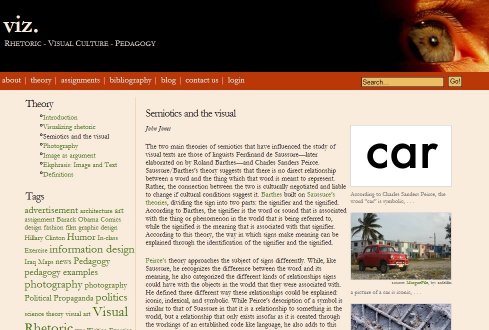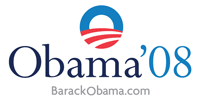Introduction
Viz., http://viz.cwrl.utexas.edu, is a blog dedicated to visual rhetoric. Created and maintained by the Computer Writing and Research Lab (CWRL) of The University of Texas at Austin and powered by Drupal, the site’s goal is to examine "the ways in which rhetoric, visual culture, and pedagogy interact with and inform each other. In keeping with this mission, the viz. blog is a forum for exploring the visual through identifying the connections between theory, rhetorical practice, popular culture, and the classroom." And the site achieves this purpose well. While offering an historical and theoretical background of the visual, Viz also includes multiple entries that comment on the many ways that visual rhetoric is defined and used in contemporary culture. The site showcases artists, teachers, and those around the web who use visual rhetoric in multiple ways. Most notably, though, the site offers examples of pedagogical strategies for creating classroom forums for students to critically discuss and analyze various types of visual argument. It even offers a few assignments for students to rhetorically analyze visual texts as well as several assignments that ask students to create their own visual arguments.
In fact, Viz seems to be a natural continuation of one of the first visual rhetoric sites in composition: David Blakesley's Visual rhetoric. Blakesley originally designed the website for a visual rhetoric course he taught in 1999. The site includes a course description, syllabus, and abstracts of student projects. However, the site has lived on largely because of its exhaustive links to other sites on visual rhetoric, even though some of them are long since dead. Even now though, the site could still be considered a visual rhetoric portal which includes everything from a website on dadaism to an Alfred Hitchcock gallery webpage and The Museum of Modern Art. Unfortunately, the Blakesley site does not include a blog or any way for others to interact by uploading articles, assignments, or links to other websites. Viz, however, does just that, not only serving as a portal to other visual rhetoric sites but also, as a blog, sustaining a dynamic scholarly community interested in sharing assignments, YouTube videos, and commentary on the intersections between popular culture and the visual.

Figure 1. Viz menu
Besides the obligatory contact and about pages, the site menu (see Figure 1) is separated into four main sections: Theory, Assignments, Bibliography, and Blog. The Blog, the highlight of the site and the frontpage for visitors, is robust, offering sixteen pages of entries since February 2007. The Theory section has entries written by John Jones and Vessela Valiavitcharska, each discussing the application of classical rhetoric to visual analysis and the image as argument. The Assignment section is split into class-length, unit-length, and semester-length assignments. The contents consist mostly of student-directed assignment sheets, most of which are by unnamed authors. The Bibliography consists of three online journals and six book links.
The Viz theory page gives the historical and theoretical background of visual rhetoric. It includes a page on the basics of semiotic theory, including Peirce, Saussure, and Barthes; explores how the rise of photography in the 19th century led to an increased interest in and awareness of the visual, especially among the middle class; and, most importantly, applies a rhetorical Aristotelian lens in analyzing the visual, arguing that logos, ethos, and pathos are all part of the construction of visual arguments. A particularly fascinating theory page discusses ekphrasis, "the rhetorically charged description of anything that can be perceived visually or evoked mentally." Finally, the theory section ends with a discussion of how contemporary surveillance becomes a form of visual rhetoric. In particular, it discusses how Google Earth can create effective visual arguments for marginalized political groups. For instance, with the satellite footage from Google Earth, Bahrain's land-deprived populace can not only see how much land the ruling family uses to build lavishly rambling palaces, they can now construct visual arguments against this power disparity. Overall, the theory pages were well balanced between history, semiotic theory, and ancient rhetorical theory. The discussion of surveillance as visual rhetoric was an effective application of all three of these aspects of visual rhetorical theory.


Figure 2. Campaign Posters for Barack Obama and
Hillary Clinton
The Viz blog is an invaluable resource for giving teachers ideas on how to generate class discussion on visual rhetoric. The site takes full advantage of the multimodality of the web and uses YouTube videos, pictures, and clips from off-site blogs to generate a discussion around visual rhetoric that most students would find appealing. With only a little imagination on the teacher’s part, any of these blog entries, pictures, or YouTube selections could instantly become intriguing classroom discussion fodder. For instance, John Jones’s blog discussing the visual differences between Bush-Cheney's and Obama’s use of visual rhetoric while on the campaign trail could easily lead to classroom discussion of how campaigns use and sometimes abuse the visual. The blog also hints at how the two campaigns use and have used ethos and pathos, which could lead to further classroom discussion. Students could then compare and contrast Barack Obama's and Hillary Clinton’s use of visual rhetoric, arguing for which was most effective (Figure 2).
The bibliography section includes three online journals: Enculturation, a "refereed journal devoted to contemporary theorizations of rhetoric, writing, and culture," Journal of Visual Literacy, which explores "empirical, theoretical, practical, or applied aspects of visual literacy and communication," and Invisible Culture, an investigation of "the material and political dimensions of cultural practices: the means by which cultural objects and communities are produced, the historical contexts in which they emerge, and the regimes of knowledge or modes of social interaction to which they contribute." The visual rhetoric and composition section includes both books on the theory of visual rhetoric as well as a few textbooks on how to teach it. While both the theory books and textbooks are not exhaustive of the field, they are good representations of some of the current work being done within composition. For instance, Carolyn Handa's (2004) edited collection of visual rhetoric within composition, Visual rhetoric in a digital world: A critical sourcebook, is included alongside Gunther Kress and Theo van Leeuwen's (2006) Reading images: The grammar of visual design, a book which has helped composition conceptualize writing as design. The bibliography compensates for not being exhaustive by including links to other online visual rhetoric bibliographies which further discuss the history and theory behind the visual—Rebecca Moore Howard's (2007) thorough visual rhetoric bibliography, Visual rhetoric: Some sources, and Wake Forest University's (2003) visual rhetoric bibliography, Sources in visual rhetoric. However, the bibliography would be easier to peruse if it included separate sections for the textbooks and theory. Right now both are mixed in with each other. Also, from a pedagogical perspective, it would be helpful if there were an outside link or two for a more exhaustive list of textbooks. For instance, while Lester Faigley and Diana George's (2004) textbook Picturing texts is included, Seeing and writing 3 by Donald and Christine McQuade (2006) is not.